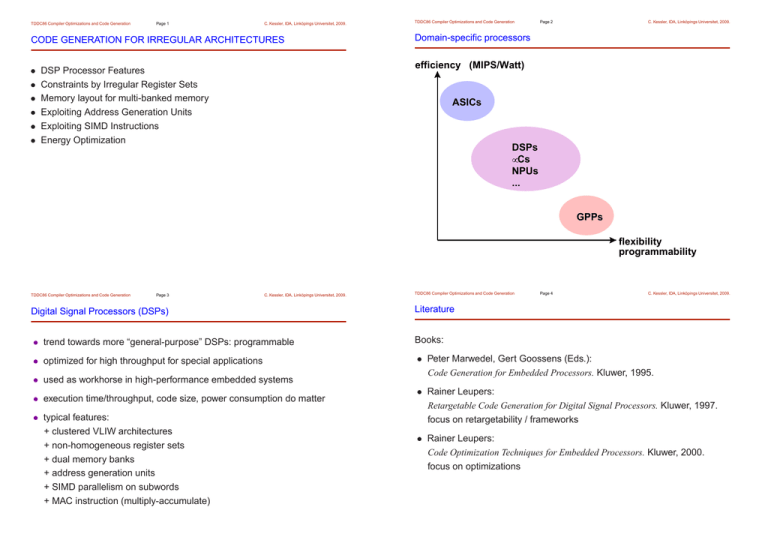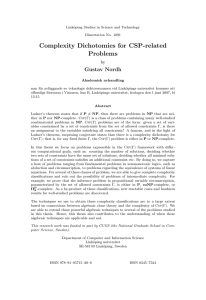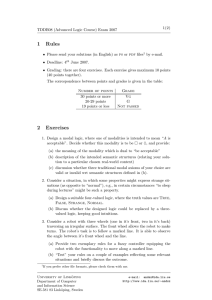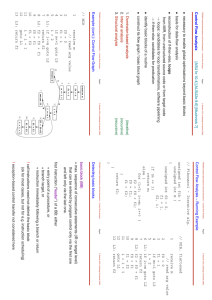TDDC86 Compiler Optimizations and Code Generation Page 2
advertisement

TDDC86 Compiler Optimizations and Code Generation
Page 1
C. Kessler, IDA, Linköpings Universitet, 2009.
TDDC86 Compiler Optimizations and Code Generation
CODE GENERATION FOR IRREGULAR ARCHITECTURES
Domain-specific processors
efficiency (MIPS/Watt)
DSP Processor Features
Constraints by Irregular Register Sets
Memory layout for multi-banked memory
Exploiting Address Generation Units
Exploiting SIMD Instructions
Energy Optimization
Page 2
C. Kessler, IDA, Linköpings Universitet, 2009.
ASICs
DSPs
µCs
NPUs
...
GPPs
flexibility
programmability
TDDC86 Compiler Optimizations and Code Generation
Page 3
C. Kessler, IDA, Linköpings Universitet, 2009.
Digital Signal Processors (DSPs)
TDDC86 Compiler Optimizations and Code Generation
Books:
optimized for high throughput for special applications
execution time/throughput, code size, power consumption do matter
typical features:
+ clustered VLIW architectures
+ non-homogeneous register sets
+ dual memory banks
+ address generation units
+ SIMD parallelism on subwords
+ MAC instruction (multiply-accumulate)
C. Kessler, IDA, Linköpings Universitet, 2009.
Literature
trend towards more “general-purpose” DSPs: programmable
used as workhorse in high-performance embedded systems
Page 4
Peter Marwedel, Gert Goossens (Eds.):
Code Generation for Embedded Processors. Kluwer, 1995.
Rainer Leupers:
Retargetable Code Generation for Digital Signal Processors. Kluwer, 1997.
focus on retargetability / frameworks
Rainer Leupers:
Code Optimization Techniques for Embedded Processors. Kluwer, 2000.
focus on optimizations
TDDC86 Compiler Optimizations and Code Generation
Page 5
C. Kessler, IDA, Linköpings Universitet, 2009.
TDDC86 Compiler Optimizations and Code Generation
Page 6
Demands on code quality
Compilation problems in embedded processors
(Critical) code for DSPs was traditionally written in assembler.
Not compiler-friendly:
More complex embedded software, shorter time-to-market
! assembler programming is no longer feasible. The lingua franca is C(++).
Compilers for embedded processors must generate extremely efficient code:
code size
system-on-chip
on-chip RAM / ROM
performance
real-time constraints
irregular data paths
special purpose registers
constrained parallelism
advanced addressing modes
special instructions e.g. MAC (multiply-accumulate)
But compilers traditionally preferred regular architectures ...
Page 7
C. Kessler, IDA, Linköpings Universitet, 2009.
More phase ordering problems: Code generation for DSPs
Program cache/Program memory
Register file A (A0-A15)
.L1
.S1
.M1
2X
.D1
TDDC86 Compiler Optimizations and Code Generation
.D2
X0
Data cache/Data memory
.M2
.S2
C. Kessler, IDA, Linköpings Universitet, 2009.
More phase ordering problems: Code generation for DSPs
X1
Register file B (B0-B15)
1X
Page 8
Example: Hitachi SH3-DSP
Clustered VLIW architectures, e.g. TI C6201:
designed for efficiency, not for ease of programming
power / energy consumption
heat dissipation
battery lifetime
TDDC86 Compiler Optimizations and Code Generation
C. Kessler, IDA, Linköpings Universitet, 2009.
Y0
data
.L2
Y1
A0
A1
M0
M1
X0
X1
paths
Y0
Y1
A0
A1
M0
M1
data paths
simultaneously e.g.
load on A
load on B
move A$B
load/
store
load/
store
data
mapping instructions to clusters
needs information about (concurrent) need of resources
instruction scheduling
needs information about residence of operands and instructions
Heuristic [Leupers’00] iterative optimization with simulated annealing
add/
sub
add + NOP
mul
paths
load/
store
load/
store
add/
sub
mul
data paths
add + mul
Residence constraints on concurrent execution (load + mul, add + mul, ...)
Instruction scheduling and register allocation are not separable!
Phase-decoupled standard methods generate code of poor quality.
TDDC86 Compiler Optimizations and Code Generation
Page 9
C. Kessler, IDA, Linköpings Universitet, 2009.
TDDC86 Compiler Optimizations and Code Generation
Page 10
C. Kessler, IDA, Linköpings Universitet, 2009.
Conflicts in instruction selection for MAC instructions
Memory layout for dual-banked memory
Instruction selection for DAGs – NP-complete
tree-pattern-matching algorithm (dynamic programming) works fine
as a heuristic for most regular processor architectures
Some VLIW architectures have multiple (typically 2) memory banks
to duplicate the memory–register bandwidth
X-data
Y-data
memory bank 1
memory bank 2
MAC?
ADD
MAC?
ADD
interconnection buses
Bank 0
unit
Bank 3
5
13
6
14
7
15
...
.....
Bank 2
4
12
...
unit
3
11
...
unit
.....
Bank 1
2
10
...
unit
byte 0 byte 1
8
9
...
Float register file
...
Integer register file
...
MUL
load/store
unit 2
...
Problem: Common subexpressions could be part
of multiple possibilities for covers by complex instructions — at most one can be realized.
load/store
unit 1
! data layout problem: how to exploit parallel loads/stores?
Constraint-logic programming [Bashford’99]
TDDC86 Compiler Optimizations and Code Generation
Page 11
C. Kessler, IDA, Linköpings Universitet, 2009.
TDDC86 Compiler Optimizations and Code Generation
Page 12
Memory layout for dual-banked memory (2)
Memory layout for dual-banked memory (3)
naive method: duplicate all data over all banks
load always from closest bank
stores must be duplicated as well for consistency
if direct moves are possible: how to schedule them?
space requirements...
Phase 1: construct bank interference graph
optimal partitioning is NP-complete [Garey/Johnsson’79]
heuristic Saghir/Chow/Lee ASPLOS-VII 1996:
“Exploiting dual data-memory banks in digital signal processors”
2 phases:
(1) build bank interference graph
(2) partition bank interference graph heuristically
start with empty bank interference graph
extension of greedy list scheduling:
C. Kessler, IDA, Linköpings Universitet, 2009.
at each zero-indegree set z
... place instructions from z into LIW as long as units available ...
if load instruction v 2 z could be scheduled
but one Load/Store unit was already assigned some u 2 z
where u and v access different variables var(u), var(v)
! requires alias analysis!
then add edge f var(u); var(v) g to bank interference graph
weighted e.g. by nesting depth
TDDC86 Compiler Optimizations and Code Generation
Page 13
C. Kessler, IDA, Linköpings Universitet, 2009.
Example: Constructing the bank interference graph
D[i]
B[i]
C[i]
C[1]
=
=
=
=
A[j]
B[j]
B[j]
A[j]
+
*
/
−
B[k]
D[k]
C[k]
C[k]
C. Kessler, IDA, Linköpings Universitet, 2009.
Phase 2: partition the bank interference graph
1
greedy heuristic – here for 2 banks
1
10
1
B[:]
Page 14
Memory layout for dual-banked memory (3)
A[:]
for (i=0; i<10; i++)
...
C[i] = A[i] + D[i]
...
TDDC86 Compiler Optimizations and Code Generation
C[:]
1
A[7] = C[j] + D[k]
1
D[:]
start with partition P = fV1 = V; V2 = 0/ g, i.e., all nodes in bank 1
#banks
cost of a partition P:
∑
i=1
∑
fu vg edge u2Vi v2Vi
;
;
;
w(fu; vg)
repeat
move a node v from V1 to V2
that yields the maximum cost reduction
until cost cannot be decreased further
+ 13..43% improvement in practice
– requires alias analysis, especially for array elements
– assumption of a large, general-purpose register file is unrealistic
TDDC86 Compiler Optimizations and Code Generation
Page 15
C. Kessler, IDA, Linköpings Universitet, 2009.
Example (cont.): Partitioning the bank interference graph
D[i]
B[i]
C[i]
C[1]
=
=
=
=
A[j]
B[j]
B[j]
A[j]
+
*
/
−
B[k]
D[k]
C[k]
C[k]
1
C[:]
1
1
D[:]
greedy choice: D[:]
Bank 1
Integration of bank allocation and register allocation:
10
1
A[7] = C[j] + D[k]
greedy choice: C[:]
Bank 2
Bank 1
Bank 2
Bank 1
Bank 2
A[:]
1
A[:]
1
1
B[:]
1
C[:]
1
D[:]
A[:]
10
1
B[:]
D[:]
1
1
1
1
C[:]
B[:]
C[:]
D[:]
Cost: 15
C. Kessler, IDA, Linköpings Universitet, 2009.
Extension: [Sudarsanam/Malik ICCAD’95, TODAES’2000]
1
B[:]
Page 16
Memory layout for dual-banked memory (4)
A[:]
for (i=0; i<10; i++)
...
C[i] = A[i] + D[i]
...
TDDC86 Compiler Optimizations and Code Generation
Cost: 3
Cost: 2
common interference graph with different kinds of edges
minimum-cost labelling of the graph: simulated annealing heuristic
TDDC86 Compiler Optimizations and Code Generation
Page 17
C. Kessler, IDA, Linköpings Universitet, 2009.
Address generation units in DSPs (1)
TDDC86 Compiler Optimizations and Code Generation
Page 18
C. Kessler, IDA, Linköpings Universitet, 2009.
Address generation units in DSPs (2)
Address registers used for autoincrement / -decrement addressing of
vector elements (small constant stride through array)
— largest potential
scalars on the stack or in global .data segment
— to optimize scalar code if address register left
If the next address accessed differs from the previous one only by a small
constant, the AGU can be used in parallel to the ALU datapaths
! more throughput, as ALU is not blocked by address calculations
Examples: TI C2x/5x, Motorola 56000, ADSP-210x, ...
Autoincrement load/store instructions exist on almost all processors
(sometimes called pop/push)
Image source: www.address-code-optimization.org
TDDC86 Compiler Optimizations and Code Generation
Page 19
C. Kessler, IDA, Linköpings Universitet, 2009.
TDDC86 Compiler Optimizations and Code Generation
Page 20
C. Kessler, IDA, Linköpings Universitet, 2009.
Single Offset Assignment problem (SOA)
Single Offset Assignment problem (SOA)
Generation of optimal address code for computations on stack-allocated scalar variables, using 1 address register with autoincrement/decrement
Given: Access sequence S (linear schedule)
Compute: Memory layout of the variables on the stack
that minimizes the number of extra address instructions required
(one single address register + one constant offset value r)
Given:
V = fv1; :::; vng local variables to be placed in the stack,
S = hs1; :::; sl i access sequence, si 2 V , 1 i l
(known, as this is done after scheduling),
find a bijective offset mapping M : V
such that Cost (M )
=
1
+
where zi = 1 if jM (si+1)
! f0
; :::;
n
1g (stack addresses)
l 1
∑ zi is minimized,
i=1
M (si)j > r, and 0 otherwise.
(Usually, this offset for autoincrement/decrement is r = 1.)
Optimal solution: NP-complete!
Image source: www.address-code-optimization.org
TDDC86 Compiler Optimizations and Code Generation
Page 21
C. Kessler, IDA, Linköpings Universitet, 2009.
TDDC86 Compiler Optimizations and Code Generation
Page 22
C. Kessler, IDA, Linköpings Universitet, 2009.
General offset assignment (GOA) problem
Algorithms for SOA
GOA: Extension of SOA for multiple (K > 1) address registers:
O(n3) heuristic [Bartley’92]
Branch-and-bound algorithm [Liao et al. PLDI’95]
build a variable affinity graph:
For each pair (si; si+1) in S increase weight of edge (si; si+1) by 1
find a maximum-weight Hamiltonian path in the affinity graph
by Branch&Bound, using a modified Kruskal MST algorithm
Given:
variable (index) set V = f1; :::; ng,
access sequence S = hvs1; :::; vsmi 2 V m; where n m, and
range of possible autoinc/-decr. offsets,
find a K-coloring of the elements in the address sequence S
= partitioning of S into K sub-access sequences Sk , k = 1:::K,
each color defines a sub-access-stream Sk = hvsk (1); vsk (2); :::; vsk (mk )i,
for each Sk , all elements appear in the same relative order as in S
and find a data layout π : V ! V in memory
that minimize overall cost CK = ∑ ∑ ∑ ci j tπ(ki) π( j)
K
n
n
S
;
k=1 i=1 j=1
;
where ci j 2 f0; 1g = cost for changing address register from i 2 V to j 2 V
and tiS j = number of times where address j occurs in S directly after i.
Example:
;
;
Heuristic [Leupers’00]: genetic algorithm.
TDDC86 Compiler Optimizations and Code Generation
Page 23
C. Kessler, IDA, Linköpings Universitet, 2009.
General offset assignment (GOA) problem: Example
TDDC86 Compiler Optimizations and Code Generation
Page 24
C. Kessler, IDA, Linköpings Universitet, 2009.
Exploiting SIMD instructions
31
16 15
0
31
31
0
+16
+16
ADD2:
16 15
16 15
0
ADD2 performs two 16-bit integer additions on the same functional unit in
one clock cycle.
Operands must reside in lower and upper 16 bits of the same registers.
Image source: www.address-code-optimization.org
Most other instructions (Load, Store, Copy, ...) work on 2x16bit pairs in the
same way as for 32bit words, thus same opcode.
Requirement for load/store of 2x16bit, 4x8bit etc.:
Consecutive layout in memory, possibly alignment constraints
Remark: SIMD data types such as 2x16bit pairs, 4x8bit quadruples etc. are sometimes referred to as ”vectors”
TDDC86 Compiler Optimizations and Code Generation
Page 25
TDDC86 Compiler Optimizations and Code Generation
C. Kessler, IDA, Linköpings Universitet, 2009.
Page 26
C. Kessler, IDA, Linköpings Universitet, 2009.
Instruction Selection for SIMD Instructions
Preparing for Selecting SIMD Instructions
Previously:
May require loop unrolling to find candidates for ADD2 matching:
Pattern matching rule reg: ADDI ( reg, reg )
void vector add ( short a[], b[], c[], unsigned int N )
reg_hi
Now add 2 new nonterminals reg hi, reg lo
(denote upper/lower register halves)
and 2 new rules for ADD2:
f
reg_lo
ADD2
ADD16
ADD16
g
reg hi: ADD2 ( reg hi, reg hi )
reg lo: ADD2 ( reg lo, reg lo )
reg_hi
unsigned int i;
for ( i = 0; i < N; i+ = 2 ) f
a[i] = b[i] + c[i];
a[i + 1] = b[i + 1] + c[i + 1];
g
reg_hi
reg_lo
ADD2
ADD16
reg_hi
ADD16
reg_lo
reg_lo
Beware of creating artificial dependence cycles when covering nodes with
complex patterns!
(see lecture on Instruction Selection)
TDDC86 Compiler Optimizations and Code Generation
Page 27
C. Kessler, IDA, Linköpings Universitet, 2009.
TDDC86 Compiler Optimizations and Code Generation
Example (cont.) — Effect of code for 1 loop iteration
Hardware-support for energy saving:
32bit Load
32bit Load
31
16 15
0
31
16 15
31
16 15
32bit register
a[i]
a[i+1]
MEMORY
+16
+16
32bit Store
0
32bit register
ADD2:
C. Kessler, IDA, Linköpings Universitet, 2009.
Energy optimization (1)
c[i]
c[i+1]
b[i]
b[i+1]
Page 28
0
Voltage scaling:
reduce voltage and frequency for non-critical program regions
Clock gating:
switch off parts of a processor (e.g. float unit) if not used for a while
Pipeline gating
switch off speculation ! reduces unit utilization
Memory accesses
reduce spill code by space-aware code selection / scheduling
TDDC86 Compiler Optimizations and Code Generation
Page 29
C. Kessler, IDA, Linköpings Universitet, 2009.
TDDC86 Compiler Optimizations and Code Generation
Page 30
Energy optimization (2)
Energy optimization (3)
Other factors that can be exploited by software:
Example: Register pipelining for ARM7 Thumb
[Steinke’01, ’02]
optimized for time:
Switching activities on buses at the bit level
CMOS circuits dissipate power if a gate output changes 0!1 or 1!0
Number of ones (“weight”) on buses may also influence power
Instruction decoding / execution: varying base costs
Energy consumption =
RT
power(t ) dt
0
but shorter time may not necessarily yield less energy
C code:
int
c =
for
{ b
b
c
}
a[1000];
a;
(i=1; i<100; i++)
+= *c;
+= *(c+7);
+= 1;
...
Loop:
LDR r3, [r2,#0]
ADD r3, r0, r3
MOV r0,#28
LDR r0, [r2,r0]
ADD r0, r3, r0
ADD r2, r2, #4
ADD r1, r1, #1
CMP r1, #100
BLT Loop
2096cc, 19.92µW s
C. Kessler, IDA, Linköpings Universitet, 2009.
optimized for energy:
...
Loop:
ADD r3, r0, r2
MOV r0, #28
MOV r2, r12
MOV r12, r11
MOV r11, r10
MOV r10, r9
MOV r9, r8
MOV r8, r1
LDR r1, [r4,r0]
ADD r0, r3, r1
ADD r4, r4, #4
ADD r5, r5, #1
CMP r5, #100
BLT Loop
2231cc, 16.47µW s
TDDC86 Compiler Optimizations and Code Generation
Page 31
C. Kessler, IDA, Linköpings Universitet, 2009.
TDDC86 Compiler Optimizations and Code Generation
Energy optimization (4)
Simulation-based power models
simulate the architecture cycle by cycle with a given program
Measurement-based models
know the set of most influential factors for power consumption
(for a family of processors)
assume power(t ) = linear combination of these, weighted by coefficients
coefficients found by measuring current drawn for simple test sequences
with an ampèremeter, by regression analysis
Examples: [Lee et al. LCTES’01], [Steinke et al. PATMOS’01]
C. Kessler, IDA, Linköpings Universitet, 2009.
Summary – Challenges for DSP code optimization
input: detailed description of the target processor
Ex.: SimplePower [Ye et al. DAC 2000], Wattch [Brooks et al. ISCA-2000]
Page 32
Instruction-Level Parallelism, Scheduling, Data layout
SIMD instructions, MAC, VLIW, clustered VLIW
Address code generation and stack data layout
Banked memory
Power consumption
power models
instruction selection and scheduling for low-power
minimize memory accesses – register allocation
Code size reduction
selective function inlining / tail merging, selective loop unrolling
instruction selection (compact instruction formats)
Retargetability — Generate or parameterize optimizer from target description



